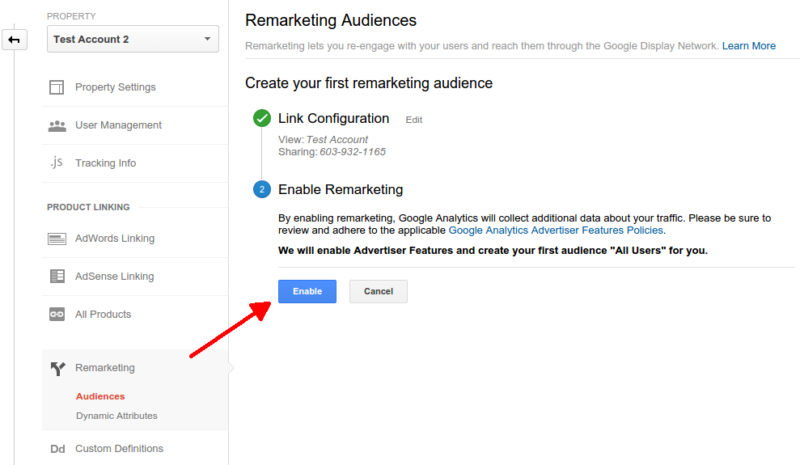Effective Strategies for Remarketing In Google Analytics
Effective Strategies for Remarketing In Google Analytics
Blog Article
Maximize Your ROI With Remarketing in Google Analytics
In the world of electronic marketing, the usage of remarketing methods within Google Analytics has confirmed to be a powerful device for improving roi. By using the power of customer data and customizing advertisements to details target market segments, services can significantly intensify their conversion rates. Nevertheless, the real vital depend on the art of precision - recognizing individual habits, crafting engaging ads, and continuously refining approaches to drive optimal outcomes. The trip to making the most of ROI with remarketing is a nuanced course led with insights and possibilities that can reshape the trajectory of your marketing endeavors.
Recognizing Remarketing in Google Analytics
Recognizing remarketing in Google Analytics is crucial for optimizing your digital marketing strategy. Remarketing enables you to target users that have formerly visited your site or interacted with your application, providing them with customized ads as they surf various other websites or make use of various other apps within the Google Present Network. This technique helps maintain your brand top of mind and motivates customers to return to your site, eventually increasing the likelihood of conversion.
By making use of Google Analytics, you can track the efficiency of your remarketing projects, getting valuable understandings into customer behavior, involvement, and conversions. This information allows you to fine-tune your messaging, targeting, and bidding process approaches to improve the overall effectiveness of your campaigns.
Moreover, recognizing the different types of remarketing checklists readily available in Google Analytics, such as standard, dynamic, and comparable audiences, permits you to develop tailored and extremely segmented projects tailored to particular individual sectors. This level of granularity can substantially improve the importance and impact of your remarketing initiatives, ultimately maximizing your roi.
Setting Up Remarketing Checklists
To properly execute remarketing campaigns in Google Analytics, the first step entails developing and setting up remarketing lists targeting details customer sections based upon their communications with your internet site or app. By establishing remarketing lists, you can tailor your advertising efforts to get to individuals who have actually already shown interest in your solutions or items.
To begin, browse to the Admin section of your Google Analytics account and choose the Property where you wish to produce the remarketing listing. Then, under the Residential property column, click 'Audience Definitions' and choose 'Audiences.' Next off, click the red 'New Audience' switch and choose 'Create New' to define the criteria for your remarketing listing.

Crafting Reliable Remarketing Ads

When crafting your ads, concentrate on producing eye-catching headings and compelling visuals that stick out to prospective clients. Include solid calls-to-action that encourage customers to redirected here review your site and complete a preferred activity. Make use of vibrant remarketing to show customized ads including items or solutions that users have actually formerly viewed on your website.
In addition, guarantee that your advertisements are mobile-friendly since a significant section of net web traffic originates from mobile phones. Test different ad variations to determine which designs and messages drive the most effective outcomes. By continually refining and optimizing your remarketing advertisements based on efficiency data, you can optimize their efficiency and enhance your return on financial investment.
Studying Remarketing Performance

Via Google Analytics, marketers can track the performance of their remarketing campaigns in real-time, allowing them to determine patterns, patterns, and areas for improvement promptly. By evaluating the information, marketing professionals can establish which advertisements are executing well, which audience sectors are responding positively, and which channels are driving the most conversions. This degree of granularity makes it possible for marketing experts to make data-driven choices to maximize their remarketing advocate far better results.
Maximizing ROI With Remarketing
Evaluating remarketing information in Google Analytics allows marketing experts to identify chances for enhancing return on investment (ROI) via tactical changes - What Is “Remarketing” In Google Analytics?. To take full advantage of ROI with remarketing, it is crucial to understand the habits of your audience. By examining individual interactions, such as the pages they saw, the items they watched, or the activities they tackled your site, you can tailor your remarketing campaigns better
Segmenting your target market based on their behavior enables you to develop tailored and targeted advertisements that are more probable to reverberate with them. By revealing appropriate ads to specific sections of your target market, you can raise the opportunities of conversion and ultimately boost your ROI.
In addition, evaluating various advertisement creatives, messaging, and deals can help identify what reverberates best with your audience. A/B testing permits you to try out various components of your ads to identify what drives the highest involvement and conversion prices.
Final Thought
To conclude, taking full advantage of ROI with remarketing in Google Analytics requires a tactical method to evaluating user habits, segmenting audiences, developing customized ads, and optimizing campaign efficiency. By leveraging data-driven insights and evaluating various techniques, organizations can enhance their remarketing efforts to drive greater engagement and conversion rates. This systematic strategy makes sure that sources are successfully designated in the direction of making the most of rois in remarketing projects.
Next off, click on the red 'New Audience' switch and pick 'Create sites New' to define the specifications for your remarketing listing.
By constantly refining and optimizing your remarketing ads based on performance information, you can optimize their effectiveness and enhance your return on financial investment.
By delving into these insights, marketers can gain advice a comprehensive understanding of exactly how their remarketing initiatives are resonating with their target audience and driving conversions. To maximize ROI with remarketing, it is crucial to understand the habits of your target market.In final thought, taking full advantage of ROI with remarketing in Google Analytics requires a tactical technique to assessing customer behavior, segmenting audiences, creating customized advertisements, and optimizing project performance.
Report this page